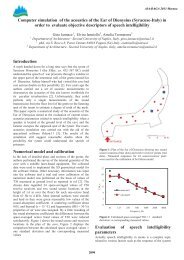ERATO Proceedings Istanbul 2006.pdf - Odeon
ERATO Proceedings Istanbul 2006.pdf - Odeon
ERATO Proceedings Istanbul 2006.pdf - Odeon
You also want an ePaper? Increase the reach of your titles
YUMPU automatically turns print PDFs into web optimized ePapers that Google loves.
In Figure 5 the reverberation time as a function of frequency in the different configurations of<br />
Aphrodisias is shown. The reconstructed model includes a coffered ceiling and open windows. All<br />
the simulations in this odeon show a similar tendency in frequency, a long and constant<br />
reverberation time at lower frequencies and an abrupt fall toward the mid-frequencies. At higher<br />
frequencies the audience and air absorption make the differences between the curves smaller. At<br />
mid- and high frequencies the reverberation time of the reconstructed model suggests that it is a<br />
room suited for musical performances.<br />
Table 2. Simulated acoustical parameters averaged over the 500-1000 Hz 1/1 octave<br />
frequency bands for the Aphrodisias Roman odeon with audience and averaged over<br />
15 receiver positions in different configurations.<br />
Theatre<br />
Configuration<br />
Acoustical Parameters<br />
T 30 (s) G (dB) C 80 (dB) STI DL2 (dB)<br />
Reference model 1,61 5,61 2,22 0,54 3,47<br />
Flat Ceiling 1,66 4,84 2,49 0,55 4,08<br />
Closed Windows 1,80 6,10 1,46 0,52 2,89<br />
Absorbing Orchestra 1,54 5,07 2,97 0,57 3,32<br />
By closing the windows with wooden shutters a considerably longer reverberation time is obtained.<br />
It is almost comparable to the reverberation time of modern concert halls of similar volume. Linked<br />
to the higher reverberation time are the overall higher strength and lower clarity. Although in<br />
general the clarity seems to be good in any of the configurations.<br />
Omission of the reflections coming from the orchestra does not cause dramatic changes but gives a<br />
higher clarity. But in general it can be said that reflections from the stage wall and the roof are more<br />
important than the reflections from the orchestra.<br />
The STI seems to be good in all the configurations making this room a suitable place for both music<br />
and spoken word.<br />
4 SUMMARY<br />
The acoustics of typical performance venues in the Roman era have been studied in detail by using<br />
computer simulations. In the computer models certain parts of the theatre have been changed or<br />
removed and the acoustical consequences of these alterations have been studied.<br />
The computer simulations show that at least two modifications introduced by the Romans in the<br />
open-air theatres had a large influence on the acoustics. Firstly the extension of the stage wall in its<br />
width and height which meant a connection with the seating area into a single structure, and<br />
secondly the colonnade in the upper part of the theatre which provided a retreat area with shade for<br />
the spectators.<br />
These two geometrical modifications of the theatre seem to increase the overall reverberation time<br />
with half a second each, amplifying the overall strength level with up to +4dB. This has to be seen<br />
as a significant improvement in this type of theatres where large distances between stage and<br />
audience implied very low levels (almost inaudible in the upper rows). Furthermore, the level<br />
25
















